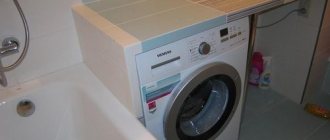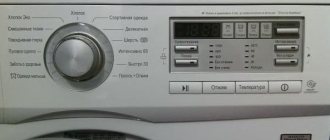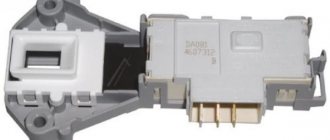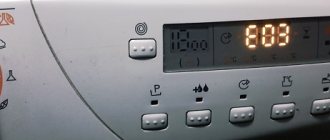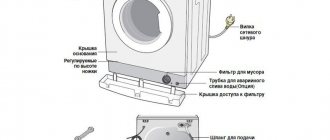Correctly selected dimensions of the washing machine will allow it to be conveniently located in the installation area, easily connect communications and create a single complex with household appliances already standing nearby.
The dimensions of the washing machine are an important selection criterion
What to consider when choosing
To choose the right size washing machine, pay attention to the following factors:
- Dimensions of the area for installation. Decide in advance on the location where the equipment will be installed. Take measurements of width, depth and height. You need to subtract 1 cm from the depth and width parameters to ensure a gap between the walls of the equipment and adjacent surfaces. This reserve is necessary to compensate for vibrations that may occur during washing and spinning.
- Location of communications. To connect the hoses to the drain and water supply pipes, you will need free space behind the back wall of the device. Taking into account the diameter of the pipes, the indentation is approximately 4-6 cm.
- The width of the doorway. A machine with a depth of more than 60 cm will not be able to fit through a standard doorway, especially when packaged, so the front panel of the unit will need to be dismantled.
- Dimensions of adjacent equipment and furniture. If you are planning to purchase a built-in model, then the height of the washing machine and its depth should be selected taking into account the height and depth of the furniture that is already installed in the selected area.
If you are planning to purchase a washing machine to be placed under the countertop, the height and depth of the unit should be selected taking into account the height and depth of the furniture installed in the selected area
Device selection criteria
When choosing a washing machine, we recommend using the parameters from the list below:
- Geometric dimensions - a device of this class is quite large. Given the limitations of modern apartments, every centimeter often matters.
- Type of layout - on the market there are built-in options or free-standing units, as well as small “under the sink” models.
- Loading model – vertical or horizontal (front).
- Linen volume is a variable that is directly related to depth.
- The principle of operation is drum, bubble or activator type, ultrasonic washing machines.
- Type of engine – inverter (more modern) or conventional.
- Washing class - most modern models have the parameter “A” or “A+”.
- Spin rate – varies from less than 45% to more than 90%. Indicated by letters from A to G (from the wettest to the dryest laundry, respectively). Usually 1000-1200 rpm is enough. Harsh settings can damage delicate fabrics.
- Electricity consumption - the most economical ones belong to class A and consume less than 0.19 kWh/kg of laundry.
- Water consumption depends on the load volume and on average varies from 36 to 60 liters per wash.
- Availability of additional functions - ionization, drying, special modes, Fuzzy Logic (smart washing), protection against leaks, the ability to load things before washing, etc.
- Noisy operation – there are no classes for this parameter, it is better to ask an expert’s opinion.
- Type of control - most are equipped with electronics, although there are also mechanical models.
- Cost, availability of promotions for the product, terms of delivery to the installation site.
- Brand, place of assembly and production, company reputation, recommendations from friends and family.
Let's now look at some of the key variables in more detail.
Types and types of device
The most compact and simple manual models. They are not automated. But they can move easily. The design is as simple as possible, but the quality of washing can be average.
Semi-automatic options are equipped with an electric motor, but cannot provide the entire process without human intervention. This is an option for rural areas where central water supply is difficult. Activator-type washing machines also fall into this category.
Automatic models are the most common type; in the city it is better to buy just this option. Programs are built into the machine. Installation requirements: availability of electricity and water.
By type of device there are:
- standard front loading options;
- narrow models with front loading of laundry;
- samples with a vertical hatch for storing things;
- non-standard miniature samples. For example, you can choose a sink above the washing machine to save space in a compact bathroom.
Size
Standard geometric dimensions of a washing machine:
- height 81-85 cm (for free-standing samples);
- height 65-70 cm (for models under the sink);
- width from 47 to 85 cm or more for individual non-standard large semi-industrial samples.
The width and depth of vertical washing machines are the same and are 40 and 60 cm, respectively. Large and standard models differ in height:
- normal version – 60-85 cm;
- increased volume – 85-100 cm.
Machine depth
An important parameter that determines the volume of items that can be washed at a time. Depth is also taken into account when integrating equipment into furniture. Typically the following gradation is used for horizontal models:
- full size – 60 cm;
- narrow – 35-40 cm;
- compact – 43-45 cm;
- built-in – 54-60 cm.
If you choose a vertical layout, the depth will be standard - 60 cm.
Load volume
Load capacity is the weight of laundry that can be loaded into the machine in one wash. Usually with this quantity the best quality of washing is achieved.
The average is 5 kg, it varies depending on the depth:
- for specimens 30-40 cm - the volume of linen is 3-5 kg;
- depth 50 cm - load 6-7 kg;
- depth 60 cm – up to 10 kg.
Standard washing machine sizes
All models of washing machines on the market can be divided into two groups: front-loading and vertical loading. Each type has its own standard parameters.
Front loading
For such models, the hatch for loading laundry is located on the front panel. When purchasing a unit with horizontal loading, it is worth considering the availability of free space in front of the device for free opening of the hatch. Size chart is below:
| Washing machine category | Height, cm | Width, cm | Depth, cm | Linen load volume, kg |
| Full size | 85-90 | 60-85 | 60 | 5-6 |
| Narrow | 85 | 60 | 35-40 | 3,5-5 |
| Compact | 68-70 | 47-60 | 43-45 | 3-3,5 |
| Built-in | 82-85 | 60 | 54-60 | 4,5-5 |
Models with horizontal loading are more popular than units with a vertical hatch. All well-known brands, such as Indesit, LG, Zanussi, offer a large selection of front-facing models. If there is a hatch on the front panel, you can use the top cover of the device as an additional work surface. The downside is the need to constantly bend over to load and unload laundry.
Top loading
When purchasing such a device, consider the availability of space above it for free opening of the hatch. Size chart is below:
| Washing machine category | Height, cm | Width, cm | Depth, cm | Laundry load rate, kg |
| Large | 85-100 | 40 | 60 | 5,5-6 |
| Standard | 60-85 | 40 | 60 | 4,5-6 |
The advantage of top-loading models is the way the drum is attached. It is fixed on two side bearings, which reduces the level of vibration during washing. The downside is the inability to use the top cover of the equipment as a stand, since it must be kept open to ventilate the drum.
What to pay attention to first
Machine type and size
The starting point is the location where the washing machine will be installed.
It is this that determines the type and dimensions of the model that suits you. There are two types of washing machines:
- Front loading (the hatch cover is on the front side).
- Vertical loading (lid on top).
Front-mounted machines, unlike vertical ones, differ quite greatly in size:
- Standard: height 85–90 cm, depth 45–60 cm, width 60 cm.
- Narrow: depth less than 45 cm.
- Compact: all parameters are smaller than standard.
Standard models are good for relatively spacious rooms because they take up the most space. Compact and narrow, suitable for installation in small spaces, under a countertop or sink. However, they have a weakness: they can break faster.
All elements inside the narrow machines are packed quite tightly. According to Stirrem-Service, this accelerates their wear and service life is reduced.
Sergey Lutkov, washing machine and dishwasher repairman
Top-loading models usually differ slightly in size and in some cases may be the only possible option.
Vertical loading is convenient if in the room where you plan to install the equipment there is little space to open the side hatch or if the lid would be in the way when opened.
Mikhail Prosvirnin, head of the Home and Self-Care department
What to buy
- Narrow top-loading washing machine Indesit MTW A51051, 26,990 rubles →
- Large front-loading washing machine from Samsung, 29,989 rubles →
- Narrow front-loading washing machine with a “caring” drum from Bosch, 34,990 rubles →
Load capacity
The second important parameter that influences the choice of machine is the loading volume you need. It is directly related to the number of people who will use the device.
There are approximate calculations according to which:
- For 1–2 people, a machine with a loading capacity of 4 kg is enough.
- For 3–5 people – 6 kg.
- For more than 5 people - 8–9 kg.
If you have small children or are planning to have them, choose models with maximum load capacity. There will be a lot of washing to do.
Don't think that maximum load volume is always the best solution.
Firstly, the more spacious the car, the larger it is, which means it takes up more space. Secondly, if you wash two items at a time in a model designed for 8 kg of laundry, the water consumption will be quite impressive. So choose the volume based on your actual needs.
What to buy
- Small washing machine with 3 kg load from Electrolux, 43,990 rubles →
- Average washing machine with 6.5 kg load from LG, 23,990 rubles →
- Narrow washing machine with 8.5 kg load from LG, 39,990 rubles →
Functionality
Modern models are equipped with basic modes (washing at different temperatures, rinsing, spinning). You just have to decide which of the additional functions you need and which will only be a waste of money.
Leak protection. This is insurance in case something is damaged in the liner or in the washing machine itself.
Special modes. They will help you save money on dry cleaning. These include programs for washing children's and sportswear, shoes, and pillows. There are also modes for removing stains or for quick washing.
Gentle wash mode. It is characterized by the use of a larger volume of water, low washing temperature and reduced spin speed. The mode is suitable for delicate fabrics and will be useful for those with a wardrobe that requires special care.
Quiet wash. Models that provide this function are equipped with an inverter motor or direct drive, so they are noticeably less noisy than usual.
Such washing machines can be safely used at night, when reduced electricity tariffs apply, and during the day they will be less distracting.
Mikhail Prosvirnin, head of the Home and Self-Care department
Steam wash. Suitable for any material, including silk, down, wool. It helps get rid of ingrained odor.
Drying. It saves time and space, since the laundry does not need to be hung after washing, but it has a very noticeable effect on the cost of the machine.
What to buy
- Washing machine with protection against leaks Candy CBWM 814DW, 29,990 rubles →
- Washing machine with “steam wash” function from Hotpoint-Ariston, 20,790 rubles →
- Washing machine with dryer from Weissgauff, 36,990 rubles →
- Quiet washing machine with inverter motor from LG, 49,990 rubles →
Washing machine weight
The dimensions of the device do not always affect how much it will weigh. In standard models, weight varies from 50 to 60 kg. You have to remember this parameter when you need to transport your car with the help of a transport company, because the greater the weight of the cargo, the more you will have to pay for its transportation. The weight of such equipment is mainly influenced by the heaviness of the drum and counterweight. The latter is necessary to reduce vibrations during washing and spinning. The smaller the body, the more counterweight is needed to suppress vibrations. Therefore, compact models weigh almost the same as full-size ones. Devices with a large weight are stable and do not produce vibration during operation.
The weight of the washing machine matters when transporting
Dimensions and functionality
When purchasing, you must take into account that the dimensions of the equipment directly affect its functionality.
Features of full-size models:
- the ability to wash from 5 kg of laundry in one go (6 kg is the average drum load);
- greater stability and absence of vibrations;
- wide range of models;
- high consumption of water and electricity.
Features of compact models:
- minimal resource consumption;
- possibility of embedding;
- high level of vibration during operation;
- The maximum volume of laundry for washing in one approach is no more than 3.5 kg.
When choosing a washing machine, pay attention to the relationship between dimensions, functionality and noise level
Having found out what length, depth and width washing machines are, consider all the options for placing the equipment. It can be located in the bathroom, in the kitchen under the sink, on the balcony, in the hallway. Pay attention to the relationship between the dimensions, functionality and noise level of the unit. Keeping all these factors in mind will help you choose the right washing machine.
